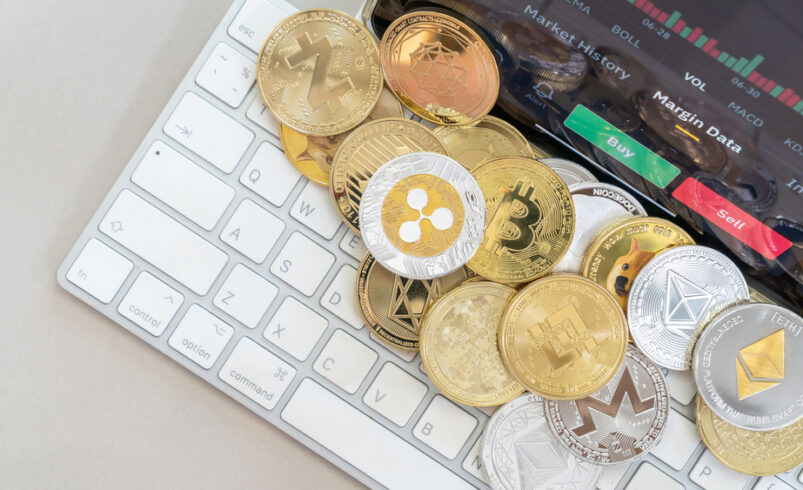Ripple’s Dive Into Stablecoin Territory: All You Need To Know

Table of Contents
Ripple, a prominent player in the blockchain and cross-border payments industry, made waves with its announcement to launch a dollar-backed stablecoin. This move marked Ripple’s entry into the stablecoin market, aiming to provide a reliable and transparent alternative to existing options. Ripple’s stablecoin aims to set a new benchmark in cryptocurrency by leveraging dependable assets to tackle issues like stability, transparency, and regulatory adherence.
Stability in Cryptocurrency
The need for stability in cryptocurrency arises from the inherent volatility of digital assets. While volatility can benefit traders seeking profit opportunities, it poses significant challenges for everyday users and businesses.
Price fluctuations make it difficult to use cryptocurrencies for daily transactions or as a reliable store of value. Moreover, volatility can hinder mainstream financial institutions and consumers’ adoption of cryptocurrencies, which require stability and predictability in their financial transactions.
Stablecoins address this need by offering a digital asset pegged to a stable fiat currency, such as the US dollar. By providing stability and predictability in value, stablecoins enable various use cases, including cross-border payments, remittances, and decentralized finance (DeFi) applications. As the demand for stablecoins grows, their role in the cryptocurrency ecosystem becomes increasingly vital in bridging the gap between traditional finance and the digital economy.
Ripple’s Entry into the Stablecoin Market
Ripple’s decision to enter the stablecoin market comes at a time of growing institutional interest in cryptocurrencies. Therefore, there is an increasing demand for stablecoins that provide the stability necessary for mainstream adoption. Ripple aims to fulfill this demand by offering a dollar-backed stablecoin that combines the benefits of blockchain technology with the stability of traditional fiat currencies.
Backing for Ripple’s Stablecoin
One of the critical features of Ripple’s stablecoin is its backing by a combination of highly reliable assets. Diverse assets, including insured US dollar deposits in banks, short-term US Treasuries, and other cash equivalents like high-quality commercial paper or money market instruments underpin Ripple’s stablecoin.
This varied backing guarantees stability and reduces potential risks, distinguishing Ripple’s stablecoin from its competitors. Apart from the dependable asset backing, Ripple prioritizes transparency and trust with its stablecoin initiative.
The company intends to undergo regular audits conducted by reputable accounting firms, releasing monthly attestation reports for public scrutiny. This commitment to transparency is vital for fostering trust among users and investors, alleviating concerns seen in certain stablecoins regarding reserve legitimacy and operational transparency.
Integration With Ripple’s Core Business
Ripple’s stablecoin initiative closely aligns with its core business of facilitating cross-border payments. The stablecoin presents an opportunity to leverage Ripple’s expertise in this area, offering faster and more cost-effective settlements for international transactions.
By integrating the stablecoin with its xRapid solution, Ripple aims to provide financial institutions with a seamless and efficient way to transfer value across borders.
Partnerships And Expansion
Ripple’s existing network of partnerships with financial institutions like Santander and Standard Chartered could play a crucial role in expanding its stablecoin project. These partnerships provide Ripple with access to a wide range of potential users and investors, facilitating the adoption and growth of its stablecoin ecosystem. By partnering with major cryptocurrency exchanges, Ripple can also increase the accessibility and liquidity of its stablecoin, further driving its adoption and usage.
Regulatory Considerations
Navigating regulatory frameworks is a critical aspect of Ripple’s stablecoin project. While the regulatory landscape surrounding stablecoins is still evolving, Ripple is committed to complying with relevant regulations in its operating jurisdictions.
In the European Union, for example, Ripple’s stablecoin would need to comply with the Markets in Crypto-Assets Regulation (MiCA), which classifies stablecoins as electronic money tokens and imposes strict requirements on issuers. In the United States, Ripple must navigate multiple government regulations, including the Commodity Futures Trading Commission (CFTC) and the Securities and Exchange Commission (SEC).
Ripple’s Approach
Despite the regulatory challenges, Ripple remains undeterred in pursuing a stablecoin solution. The company’s emphasis on transparency and high-quality backing assets positions its stablecoin project favorably within regulatory frameworks.
Regular audits by reputable accounting firms and adherence to AML/CFT regulations reinforce Ripple’s commitment to compliance and legitimacy. However, achieving regulatory clarity in jurisdictions like the US remains a priority, requiring patience and strategic maneuvering.
Market Potential
The market potential for stablecoins is vast, driven by the growing demand for stability and predictability in cryptocurrency. With institutional interest rising and the increasing adoption of digital assets in various industries, stablecoins have become essential tools for facilitating transactions, managing volatility, and accessing decentralized financial services. Tether’s impressive financial performance in 2023, with $6.2 billion in annual net income, underscores the immense potential for institutional-backed stablecoin projects.
Conclusion
By offering a reliable and transparent alternative to existing stablecoins, Ripple aims to address the need for stability in the market and accelerate the adoption of digital assets. With its focus on high-quality backing assets, transparency, and regulatory compliance, Ripple’s stablecoin project can reshape the future of cross-border payments and finance.
Time Crypto Market offers content visibility for dozens of crypto enterprises, and you can be a part of our network! Reach out to us on our telegram chat for inquiries. The nature of cryptocurrencies is highly unpredictable; always perform your due diligence before any investment. Several articles on our site come from guest contributors or are commissioned pieces, not originating from Time Crypto Market's in-house writers. The perspectives shared in these articles might not necessarily align with those of Time Crypto Market. We do not assume responsibility for the veracity, caliber, promotions, offerings, or any other elements presented on our platform. Consult our comprehensive terms of service and disclaimer for more details.








